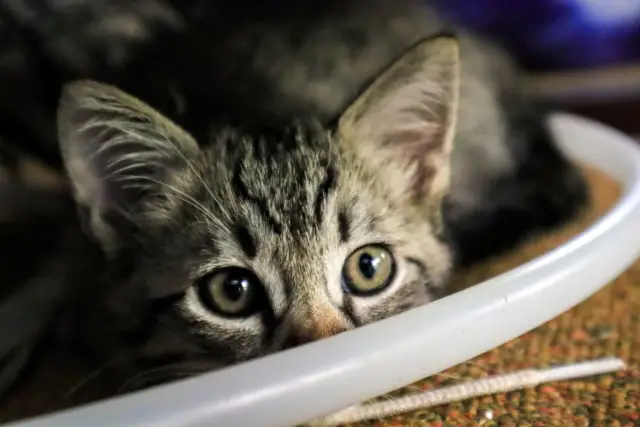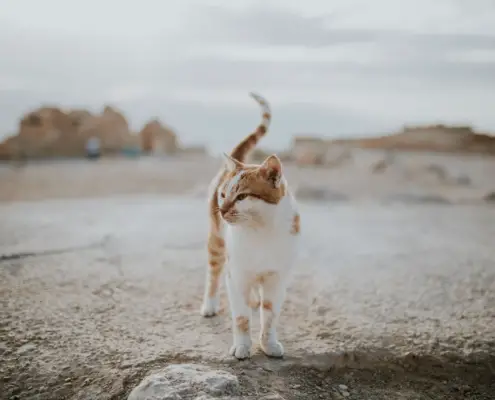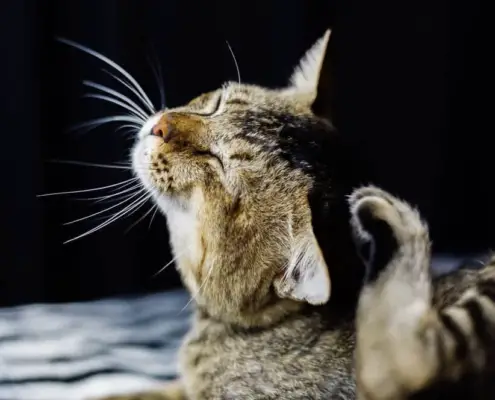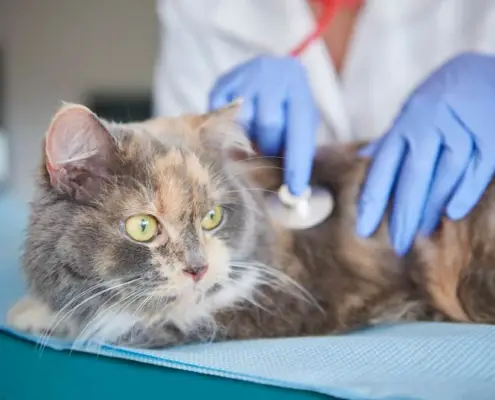
Cats have always been mysterious creatures with their piercing eyes and agile movements. One of the common myths surrounding cats is that they are nearsighted. However, this belief is far from the truth. To truly understand the eyesight of cats, it is essential to debunk this myth and explore the fascinating world of feline vision.
The common myth: Cats are nearsighted
For years, many people have believed that cats are nearsighted, meaning they have difficulty seeing objects in the distance. This misconception can be attributed to the fact that cats rely heavily on their other senses, such as hearing and smell, when navigating their surroundings. While it is true that cats have a keen sense of hearing and a highly developed sense of smell, their eyesight is not as limited as commonly believed.
Debunking the myth: Cats are actually farsighted
Contrary to popular belief, cats are not nearsighted but rather farsighted. This means that they have better vision when it comes to objects that are farther away. Cats have an incredible ability to detect movement from a distance, which is essential for their survival as predators. Their eyes are designed to focus on distant objects, allowing them to spot potential prey or threats from afar.
The structure of a cat’s eye contributes to their farsightedness. Cats have a larger cornea and lens compared to humans, which enables them to gather more light and focus on objects in the distance. Additionally, their eyes have a higher number of rod cells, which are responsible for detecting motion and low light levels. This abundance of rod cells gives cats an advantage when it comes to hunting in dimly lit environments.
How cats’ eyesight compares to humans
To fully grasp the unique nature of cats’ eyesight, it is important to compare it to the vision of humans. While humans have a wider range of visual acuity, cats excel in other aspects. Cats have a wider field of view, allowing them to see more of their surroundings without turning their heads. Their eyes are also more sensitive to motion, making them excellent hunters.
However, cats do have certain limitations in their vision compared to humans. Cats have difficulty distinguishing between colors, as they only have two types of color-detecting cells (cones) in their retinas, while humans have three. This means that cats see the world in shades of blue and green. Despite this limitation, cats compensate for their color blindness with their exceptional night vision and ability to detect even the slightest movement.
Factors that affect cats’ eyesight
While cats naturally possess remarkable eyesight, there are certain factors that can affect their visual capabilities. One such factor is age. As cats grow older, their eyesight may deteriorate, just like in humans. This can lead to conditions such as cataracts or glaucoma, which can impair their vision. Regular check-ups with a veterinarian can help identify and manage these conditions to ensure the best possible eye health for cats.
Another factor that can affect cats’ eyesight is genetics. Certain breeds of cats may be more prone to eye-related disorders, such as Persians and their susceptibility to tear duct blockages. It is important for cat owners to be aware of their cat’s breed and potential eye health issues associated with it. Regular observation and prompt veterinary attention can help address any concerns and maintain the overall eye health of cats.
Signs that indicate cats’ eyesight problems
As responsible cat owners, it is crucial to be vigilant for any signs that indicate potential eyesight problems in our feline companions. Some common signs to look out for include:
- Excessive tearing or discharge from the eyes
- Redness or swelling of the eyes
- Frequent squinting or blinking
- Cloudiness or haziness in the eyes
- Bumping into objects or seeming disoriented
- Changes in behavior, such as decreased interest in playing or exploring
If any of these signs are observed, it is recommended to seek veterinary attention promptly. Early detection and treatment of eyesight problems can significantly improve the quality of life for cats and prevent further complications.
How to maintain cats’ eye health
Maintaining the eye health of cats is essential to ensuring their overall well-being. Here are some tips to help cat owners keep their feline friends’ eyes in optimal condition:
- Keep the environment clean: Regularly clean the areas where your cat spends time to minimize the risk of eye infections caused by dirt or debris.
- Monitor their diet: Providing a balanced and nutritious diet can support good eye health. Consult with your veterinarian to ensure your cat’s diet includes essential nutrients for eye health, such as Vitamin A.
- Regular grooming: Cats with long hair may be more prone to eye irritations. Regular grooming sessions can help prevent hair from irritating their eyes and reduce the risk of infections.
- Avoid exposure to harmful substances: Keep household cleaning products, chemicals, and other potentially harmful substances away from your cat’s reach, as they can cause serious eye injuries.
- Preventative measures: If your cat spends time outdoors, consider using cat-friendly goggles or protective eye-wear to shield their eyes from potential hazards, such as debris or UV radiation.
Tips for playing and interacting with cats based on their eyesight
Understanding cats’ unique eyesight can enhance the way we interact and play with them. Here are some tips to keep in mind:
- Use toys that stimulate their hunting instincts: Cats have excellent motion detection abilities. Choose toys that mimic the movement of prey, such as feather wands or interactive toys that can engage their natural hunting instincts.
- Provide elevated perches and climbing opportunities: Cats love to observe their surroundings from elevated positions. Providing tall cat trees or perches near windows can allow them to watch the world outside and exercise their keen eyesight.
- Be mindful of their depth perception: Cats’ depth perception may not be as accurate as humans’. Avoid placing toys or treats on high surfaces that require precise depth perception to reach to prevent accidents or frustration.
- Give them visual cues during play: Cats rely on visual cues to understand their environment. Incorporate visual signals, such as hand movements or gestures, during playtime to enhance their engagement and enjoyment.
- Create a safe and stimulating environment: A well-enriched environment with various textures, hiding spots, and interactive toys can keep cats mentally stimulated and support their overall eye health.
The importance of regular veterinary check-ups for cats’ eyesight
Regular veterinary check-ups play a crucial role in maintaining the eye health of cats. During these check-ups, veterinarians can thoroughly examine the eyes, identify any potential issues, and provide appropriate treatment or preventive measures. Additionally, veterinarians can also offer valuable advice on specific eye care needs based on the cat’s age, breed, and overall health.
Early detection of eye problems can prevent further complications and ensure that cats receive prompt and appropriate treatment. Regular check-ups also provide an opportunity to discuss any concerns or observations regarding cats’ eyesight with a trained professional, ensuring that their vision remains in optimal condition.
Cats’ eyesight is unique and fascinating
In conclusion, the eyesight of cats is a topic filled with intrigue and misconception. Debunking the myth that cats are nearsighted, we discovered that they are actually farsighted. Their remarkable vision, coupled with their exceptional night vision and motion detection abilities, make them formidable hunters.
Understanding the factors that can affect cats’ eyesight, as well as the signs that indicate potential problems, allows us to take better care of our feline companions. By maintaining their eye health through regular check-ups, providing a safe environment, and engaging in activities that cater to their unique vision, we can ensure that cats continue to thrive and enjoy their surroundings.
If you enjoyed my article, I would appreciate you sharing it with your network.

Sima Ndlebe
Sima writes for CatBuzz. He is interested in Cats, Health and Fitness, and Entrepreneurship.
Published: 19 December 2023
Related Articles
Disclaimer
The content found on CatBuzz.org is presented on an "as is" basis and is intended for general consumer information and education purposes only. Any utilization of this information is voluntary and solely at the user's own risk.
None of the articles or content should be regarded as, or used in place of, veterinary medical advice, diagnosis, or treatment. The information provided on the website is purely for educational and informational intentions and should not be considered a substitute for professional guidance from a veterinarian or other qualified expert. The articles are designed to inform consumers about veterinary healthcare and medical matters that may impact their cat's daily life. It should be noted that this website and its services do not constitute the practice of any form of veterinary medical advice, diagnosis, or treatment. CatBuzz.org explicitly disclaims any liability for any direct or indirect damages or losses that may arise from the use of or reliance on the information contained within the content.
Consumers must consult a veterinarian, veterinary specialist, or another qualified veterinary healthcare provider when seeking advice regarding their cat's health or medical conditions. It is important not to ignore, avoid, or postpone seeking medical advice from a veterinarian or other qualified veterinary healthcare provider solely based on information obtained from this website. If you believe that your cat may be experiencing a medical issue or condition, it is imperative to promptly contact a qualified veterinary healthcare professional.



